This is not what we mean when we talk about a flooded engine, although many adventure and enduro motorcycle engines have ended up full of water!
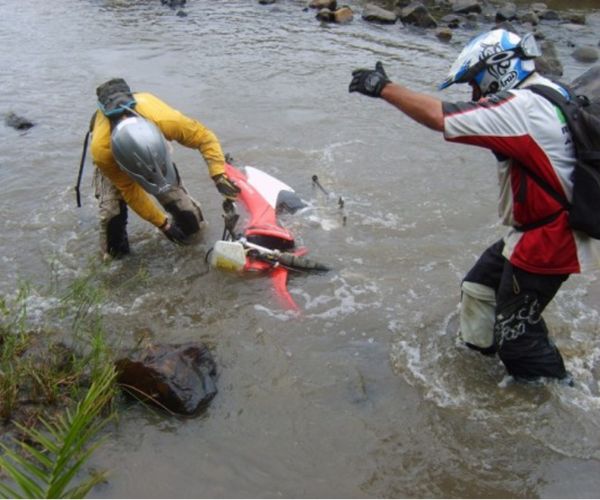
No, we are talking about a motorcycle engine flooded with fuel.
How a motorcycle engine gets flooded with fuel and what we need to do to fix the problem is what we are discussing today.
Symptoms of a flooded engine
If you suspect you have flooded your motorcycle engine, there are some symptoms to look out for;
- The engine turns over but won’t start
- You can smell fuel
- Excess fuel coming out of the exhaust
What causes a flooded motorcycle engine?
There are several ways a motorcycle engine can flood, so we’ll look at them in no particular order and find ways to fix the problem.
Carbureted engines are more prone to flooding, while engines with fuel injection should only become flooded if there is a fault.
Cause 1 – Too much choke
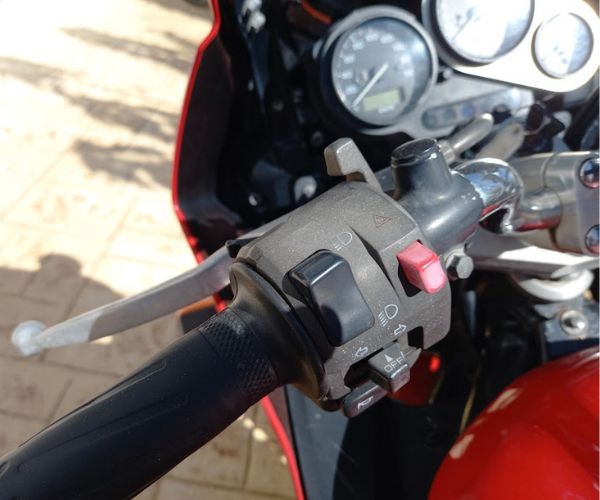
Bikes with carburetors will have a choke to help start the engine in cold weather. The choke restricts the airflow into the carburetor, increasing the fuel in the fuel-air mix.
If you have too much choke, the excess fuel will make the spark plugs wet and prevent them from sparking efficiently. Fuel injection engines do not have a choke, as the ECU manages the correct amount of fuel-air mixture.
Fix – Adjust the choke to give an even tick over
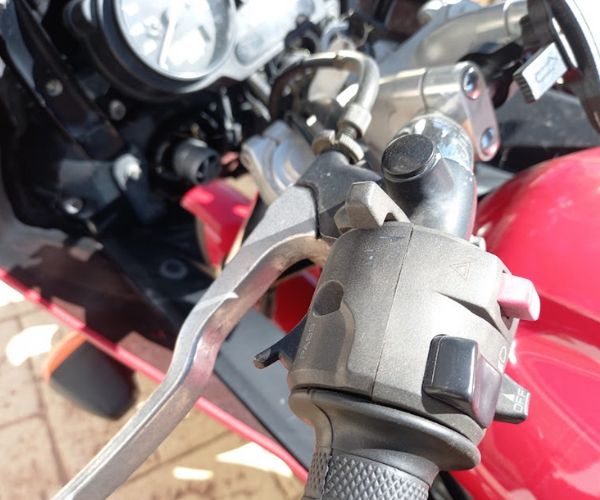
The fix is to practice and learn how your motorcycle engine responds to the choke. When you start your motorcycle engine, only use a small amount of choke and add more if the engine does not start.
Some engines are very sensitive to choke adjustments. The aim is to get the engine running smoothly by increasing or reducing the choke.
Cause 2 – Opening the throttle when starting your motorcycle
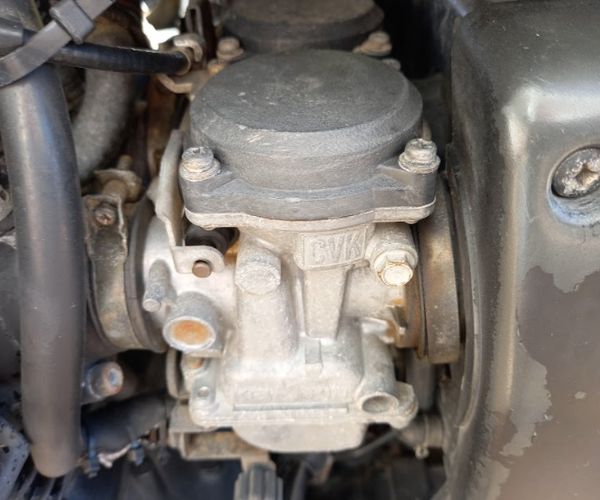
Motorcycle engines with carbs often need to be started in a particular way; sometimes, that means giving the engine a little bit of throttle.
It’s a delicate balance between getting your motor running, giving too much throttle, and flooding the engine.
This is particularly true in cold weather, where you also use the choke. Fuel-injected engines don’t need any throttle opening when being started.
Fix – Gentle throttle control and practice!
If you have a bike that needs a little throttle to start, try to use small movements, judging when the engine catches.
The only way to get this right is through practice, listening to the engine, and adapting your throttle movements.
Cause 3 – Leaving the fuel tap open
Carbureted bikes are fed fuel by a gravity feed from the fuel tank. In normal operation, the float bowls in the carburetor will prevent excess fuel from getting through to the engine.
However, carbs are a mechanical component, and excess fuel can get into the engine, particularly on older bikes.
Fix – Close the fuel tap
Simply remembering to close the fuel tap will prevent this problem.
Cause 4 – Faulty spark plugs
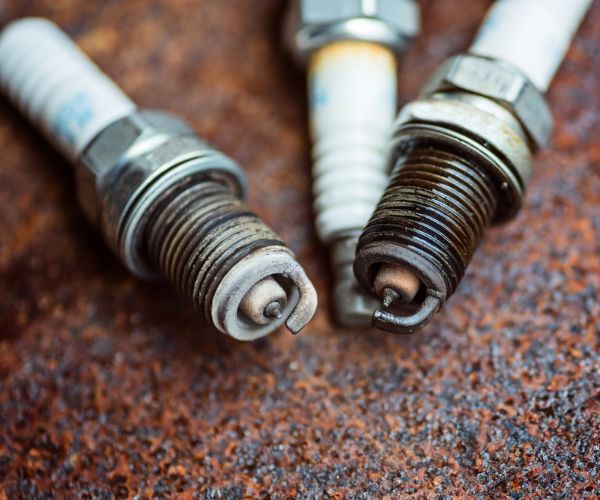
Spark plugs have a tough life! They operate at temperatures between 932 and 1472 Fahrenheit in a pressurized chamber that can reach 4500 Fahrenheit when the fuel-air mixture ignites.
Not surprisingly, we need to check our motorcycle’s spark plugs regularly.
When your spark plugs begin to fail, they won’t ignite the fuel mixture properly. This causes sooty deposits to form on the plug, compounding the problem.
Eventually, if you don’t do anything, the spark won’t be enough to ignite the fuel, and the plugs will become wet with fuel i.e. flooded.
Fix – Replace your spark plugs
The replacement of an engine’s spark plugs is typically based on mileage. In most cases, it’s at every other major service, but this varies between bikes. Check your service manual, and don’t skip this relatively simple task.
Cause 5 – Faulty ignition system

Similar to failing spark plugs, if your ignition system develops a fault, the fuel mixture will not ignite fully or at all.
There are many components in the ignition system, so we’ll mention the main culprits that might cause engine flooding.
Fix – Check the bikes ignition system
The leading cause is usually failing ignition coils. This component provides the high power required to create the spark at the spark plug. They can degrade slowly, reducing the spark but making the engine more difficult to start.
Another possibility on older bikes with mechanical timing is the ignition contact points. These simple devices are a switch opened and closed by the rotation of the crankshaft. They need to be set up correctly so that the spark occurs at the right moment.
Cause 6 – Switching the engine off too quickly after starting from cold
Starting an engine from cold, particularly in cold weather, and switching it off after a few seconds can cause flooding.
Because the engine hasn’t had time to warm up, unburnt fuel can be left in the chamber, making the spark plugs wet.
Fix – Allow your engine to idle for a short time
If you start your bike just to move it out of the garage to the drive, then allow it to run for a little while.
The temperature in the combustion chamber quickly rises, so even after a minute, it will be hot enough to prevent flooding. Note that this cause is more common on cold, damp days.
Starting a flooded motorcycle engine
The first thing to do is confirm the bike is flooded. If it’s easy to access the spark plugs, take one out and inspect it. If the plug is wet with fuel, there is too much unignited fuel in the combustion chamber.
If your motorcycle has carbs and you think you may have used too much choke or throttle, then if possible, remove the plugs and allow them to dry.
If the plugs are too tricky to get at, you can just wait for the fuel to evaporate in the chamber, but it will take longer, maybe 15 to 20 minutes.
A standard method to clear a flooded engine is to hold the throttle fully open and crank the engine.
This might seem counterintuitive, but with the throttle fully open, you add much more air into the combustion chamber and blow out the excess fuel.
It may take ten seconds or more for this method to work, but you should start to hear the engine trying to fire. Once the engine starts, hold the idle speed slightly higher than usual.
Also read: Why does my bike die when given throttle?
Preventing a flooded engine
Regular maintenance will help to prevent flooding. Your engine should start easily with your ignition system in good condition and the correct fuel mixture.
Learning how your motorcycle reacts to the choke and throttle during starting will help you anticipate a flooded engine.
If your motorcycle floods often, then there might be a problem. Either service the motorcycle yourself or take it to a good mechanic.
And Finally
Modern fuel-injected motorcycles are far less to flood unless there is a problem. However, motorcycles with carbs sometimes need a little more mechanical sympathy. Getting to know your bike through regular maintenance can help you here.